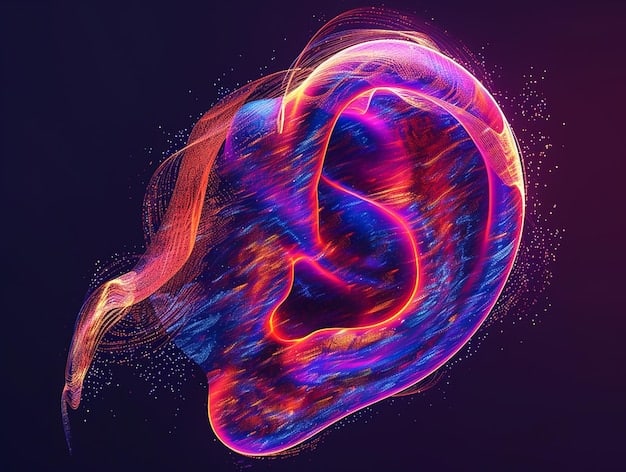Music Streaming & AI: Personalized Playlists Evolution

The continuous **evolution of music streaming: how AI is shaping personalized playlists** is revolutionizing discovery, empowering artists, and enhancing user experiences through sophisticated algorithms that analyze individual preferences and behavioral patterns, leading to more engaging and tailored listening journeys for millions of global subscribers.
The landscape of how we consume music has been dramatically reshaped over the past two decades. From physical media to digital downloads, and now, to the ubiquitous realm of streaming, access to a vast universe of sound has never been easier. At the heart of this transformation lies **the evolution of music streaming: how AI is shaping personalized playlists**, turning passive listeners into active explorers and creating an unprecedented level of individual connection with artists and genres. This shift is not merely about convenience; it signifies a profound change in music discovery, distribution, and even creation.
The Dawn of Digital Music and Initial Streaming Ventures
The journey of music streaming began long before the mega-platforms of today dominated the market. It was a gradual progression from file-sharing models to subscription-based services, each step laying the groundwork for the intricate AI-driven ecosystems we recognize now. Understanding this initial phase provides crucial context for appreciating the monumental impact of artificial intelligence.
Early digital music was characterized by a push for accessibility, which often clashed with traditional industry models. The advent of MP3s and peer-to-peer sharing platforms, while controversial, undeniably demonstrated a strong consumer demand for digital access to music. This era catalyzed the music industry’s eventual pivot towards digital distribution, albeit reluctantly at first.
From Downloads to Early Streaming Paradigms
The transition from standalone digital files to streaming was a significant technological leap. Early streaming services aimed to offer convenience without requiring large local storage. However, they faced numerous challenges, including bandwidth limitations, licensing complexities, and the nascent state of recommendation technology.
- Limited catalogs: Initial streaming platforms often had smaller music libraries due to licensing hurdles.
- Basic interfaces: User interfaces were generally rudimentary, focusing on functionality over discovery.
- Manual curation: Playlists were largely curated by human editors or based on simple genre classifications.
- Bandwidth constraints: Streaming quality was often compromised by internet speeds, limiting adoption.
These early attempts, while imperfect, established the fundamental concept: music as a service rather than a product. They taught valuable lessons about user behavior and the technical demands of delivering audio content on demand.
Building the Foundation for Future Innovation
The challenges of the early streaming landscape inadvertently created a fertile ground for innovation. As technology advanced and internet speeds improved, the potential for more sophisticated services became apparent. The dream of a truly personalized music experience, however, remained largely unfulfilled without the computational power and analytical capabilities that AI would soon offer.
In essence, the initial period was one of foundational building. It was about proving the viability of streaming as a business model and a consumer preference, setting the stage for the transformative power of artificial intelligence to enter the scene and redefine what was possible in music discovery.
Artificial Intelligence Enters the Soundscape: Beyond Basic Recommendations
The true revolution in music streaming commenced with the integration of artificial intelligence. Initially, recommendation systems were relatively simplistic, often based on collaborative filtering—suggesting tracks liked by users with similar listening habits. However, AI, through its various sub-disciplines, pushed the boundaries far beyond this rudimentary approach.
Modern AI in music streaming utilizes a complex interplay of algorithms, data points, and machine learning models to understand not just what users listen to, but why they listen to it, and how they might feel while doing so. This depth of analysis transforms a simple recommendation into a genuinely personalized journey.
Understanding User Behavior with Machine Learning
Machine learning lies at the core of advanced personalization. Algorithms analyze vast datasets, including listening history, skips, repeats, explicit likes, time of day, device usage, and even transitions between songs. This behavioral data provides a rich tapestry from which AI draws insights.
- Collaborative filtering refinement: AI enhances traditional methods by identifying more subtle similarities between users.
- Content-based filtering: Analyzing audio features (tempo, key, instrumentation) to recommend similar-sounding tracks.
- Sequence modeling: Predicting the next song based on the flow and context of a listening session.
- Real-time adaptation: Recommendations dynamically adjust as user behavior changes within a single session.
This granular understanding allows AI to move beyond obvious genre categorizations, uncovering hidden connections and often surprising users with music they didn’t know they needed.
The Rise of Generative AI in Music
Beyond recommending existing tracks, generative AI is beginning to influence music in more profound ways, including aspects of creation and remixing. While still in its early stages, the potential for AI to aid artists or even compose original pieces for specific moods or purposes is immense. This frontier of AI is exploring how to not only analyze music but also produce it.
The application of AI extends beyond simple suggestions; it’s about predicting taste, anticipating mood, and fostering a deeper connection between listener and sound. This leap represents a significant shift from passive consumption to an active, individually tailored listening experience, continuously refined by the intelligence embedded within the platforms.

Dissecting Personalized Playlists: Algorithms at Work
Personalized playlists are the crown jewels of modern music streaming, and their creation is a complex ballet of advanced algorithms. These aren’t just shuffled lists of songs; they are carefully constructed auditory experiences designed to resonate with individual users on a profound level. The process begins with data ingestion and moves through multiple layers of analysis.
At the heart of these systems are algorithms that understand both explicit signals (likes, saves) and implicit signals (skips, listening duration, repeated plays). By combining these, AI builds a comprehensive profile of a user’s musical preferences, including genres, moods, tempos, and even the specific artists and eras they favor.
Key Algorithmic Components in Personalization
Multiple layers of algorithms collaborate to produce a personalized playlist. Each component plays a vital role in refining accuracy and discovering new music for the user.
- Matrix factorization: Identifies underlying factors that explain user preferences and song attributes.
- Deep learning networks: Analyze raw audio data and user interactions to find complex patterns.
- Reinforcement learning: Learns from user feedback (e.g., whether a recommended song was skipped or enjoyed) to improve future suggestions.
- Natural Language Processing (NLP): Used to understand user-generated text (e.g., search queries, playlist titles) and connect it to musical attributes.
These components allow systems to go beyond simplistic “if you like X, you’ll like Y” rules, instead building dynamic models that evolve with the user’s taste.
From Echo Chambers to Discovery Engines
One of the persistent challenges for personalized playlists is avoiding “filter bubbles” or “echo chambers,” where users are only recommended music similar to what they already know. Savvy AI systems actively combat this by incorporating elements of exploration.
Algorithms often introduce a certain percentage of “discovery tracks”—songs that deviate slightly from the user’s established preferences but share underlying musical similarities or are popular among users with parallel tastes. This balance between familiarity and novelty is crucial for sustained engagement and genuine music discovery.
The sophistication of these algorithmic processes is what differentiates a truly engaging personalized playlist from a mere collection of songs. They are engineered to predict delight, making each listening session a carefully orchestrated experience.
The Impact on Artists and Music Discovery
The rise of AI-driven personalized playlists has fundamentally altered the ecosystem for both established and emerging artists, as well as the way listeners discover new music. It’s a double-edged sword, offering unprecedented exposure while also presenting new challenges in an increasingly algorithm-driven world.
For artists, the potential reach is global and instantaneous. A track can go from obscurity to viral sensation overnight if it resonates with the algorithms and, consequently, with a wide audience. This democratic potential empowers independent artists and those outside mainstream labels.
Democratizing Music Discovery While Raising New Challenges
AI’s ability to match music with individual tastes means that niche genres and artists can find their audience without traditional mass marketing. This democratization of discovery is one of the most celebrated aspects of personalized streaming.
- Breakout potential: Unknown artists can gain significant traction through algorithmic inclusion in popular playlists.
- Niche audience reach: AI helps connect specialized music genres with dedicated listeners worldwide.
- Reduced reliance on gatekeepers: Less dependence on traditional radio or music critics for exposure.
- Data-driven insights for artists: Artists can gain valuable audience data to inform their creative and promotional strategies.
However, this new landscape also introduces the pressure of “algorithmic optimization.” Artists and their teams often strive to create music that is “algorithm-friendly,” potentially influencing creative choices.
The Shifting Role of Curation
While algorithms play a dominant role, human curation hasn’t disappeared. Instead, its role has evolved. Human curators often seed initial playlists or provide thematic expertise that algorithms then learn from and scale. The synergy between human insight and AI’s processing power is proving to be the most effective approach.
Ultimately, AI has reshaped the path from artist to listener, creating a more direct and personalized connection. It has expanded the horizons of music discovery beyond what seemed possible, fostering diversity and innovation within the industry.
Ethical Considerations and Future Trajectories of AI in Music
As AI’s role in music streaming deepens, so do the discussions surrounding its ethical implications and future potential. From issues of fairness and transparency to potential biases and the evolving role of human creativity, these considerations are crucial for the sustainable growth of personalized music experiences.
One primary concern revolves around algorithmic bias. If historical listening data reflects existing biases (e.g., disproportionate representation of certain demographics or genres), the AI might inadvertently perpetuate or even amplify these biases in its recommendations, limiting discovery for some users or artists.
Addressing Bias and Ensuring Fairness
Ensuring fairness in AI recommendations requires conscious effort in data collection, algorithm design, and continuous monitoring. Developers are increasingly focused on building AI systems that are transparent in their decision-making processes and equitable in their outcomes.
- Diverse training data: Actively diversifying datasets to represent a broader range of musical tastes and cultural backgrounds.
- Algorithm audits: Regular reviews of algorithms to identify and mitigate unintended biases.
- User control: Providing users with more control over their recommendation preferences and explicit feedback mechanisms.
- Transparency in features: Explaining why certain songs are recommended to build trust and understanding.
The goal is to create systems that are not only personalized but also universally fair and inclusive, ensuring that all artists have a chance to be heard and all listeners have access to a diverse musical universe.
The Horizon: Hyper-Personalization and Beyond
Looking ahead, the future of AI in music streaming promises even deeper personalization. Imagine playlists that adapt not just to your mood, but to your activity, location, or even biometric data, creating truly adaptive soundscapes.
Further integration of AI could lead to more interactive experiences, where users actively participate in shaping their musical journeys through advanced voice commands or augmented reality. The convergence of AI with other emerging technologies will undoubtedly unlock new dimensions of musical appreciation, continuing to push the boundaries of what is possible in the world of sound.

User Experience and Engagement: The Core Benefit of AI Playlists
At the heart of the “why” behind AI’s pervasive role in music streaming lies the profound enhancement of user experience and engagement. Personalized playlists are not just a technological marvel; they are a fundamental shift in how individuals interact with and derive value from music, fostering deeper connections and longer listening sessions.
Before AI, discovering new music often felt like a chore, requiring active searching, sifting through vast catalogs, or relying on limited radio programming. AI has transformed this into an effortless, delightful journey tailored to each listener’s unique taste profile.
Seamless Discovery and Reduced Decision Fatigue
One of the most significant benefits of AI-driven playlists is the alleviation of decision fatigue. With millions of songs available, choosing what to listen to can be overwhelming. AI streamlines this process, presenting relevant options without extensive user input.
- Effortless exploration: Users are introduced to new music without manual search or curation.
- Higher satisfaction: Recommendations often align so well with taste that they feel like genuine discoveries.
- Increased stickiness: Users spend more time on platforms where content consistently resonates.
- Mood-driven suggestions: Playlists often cater to specific moods or activities, enhancing relevance.
By consistently delivering music that resonates, AI transforms the listening experience from a passive act into an engaging, dynamic interaction, making the platform indispensable to the user’s daily life.
Fostering Deeper Connections with Music
Beyond convenience, personalized playlists foster a deeper, more emotional connection with music. When a recommended song perfectly captures a feeling or introduces a new favorite artist, it reinforces the value of the platform and the power of its underlying AI.
This enhanced engagement translates directly into higher retention rates for streaming services and a more vibrant ecosystem for artists. It is a virtuous cycle: better AI leads to better user experience, which leads to more engagement, generating more data for the AI to further refine its recommendations. The constant refinement ensures that the user experience remains fresh and compelling, solidifying the central role of AI in the future of music consumption.
Monetization and Business Models: AI’s Economic Footprint
The impact of AI on music streaming extends far beyond the listener’s ear, profoundly influencing the business models and revenue streams of streaming platforms. By enhancing personalization and engagement, AI directly contributes to user retention, subscription growth, and diversified monetization strategies, reshaping the economic landscape of the music industry.
At its core, AI helps streaming services maintain a competitive edge. In a crowded market, the ability to offer a uniquely tailored and consistently satisfying experience is a major differentiator. This leads to longer subscriber lifecycles and a reduced churn rate, which are critical metrics for profitability.
Driving Subscriptions and Engagement
Personalized playlists and AI-driven features are key drivers of subscription uptake. When prospective users experience the power of effortless music discovery and tailored listening, the value proposition of a paid subscription becomes significantly more compelling.
- Increased perceived value: The quality of personalized recommendations justifies subscription costs.
- Reduced churn: Engaged users who consistently find new music they love are less likely to cancel.
- Tiered services: AI-driven features often differentiate premium subscription tiers from free, ad-supported versions.
- Expansion into new markets: Personalized content can more easily attract diverse global audiences.
Furthermore, higher engagement translates into more listening hours, providing more opportunities for advertising revenue in freemium models and strengthening the overall ecosystem.
New Revenue Streams and Artist Support
AI’s role in business evolution isn’t limited to subscriptions. It opens doors to novel revenue streams and more efficient ways to support artists. For instance, targeted advertising becomes far more effective when informed by sophisticated AI-driven user profiles, leading to higher ad rates.
Moreover, AI can help identify emerging trends and artists, allowing platforms to strategically invest in content or promote tours and merchandise. This data-driven approach to business development ensures that platforms are not just distributors but also active participants in shaping the future of music commerce, ensuring AI’s deep economic footprint for years to come.
| Key Aspect | Brief Description |
|---|---|
| 🎶 AI’s Core Role | Drives personalization, moving from simple recommendations to deeply tailored listening experiences. |
| 🧠 Algorithmic Depth | Utilizes machine learning, deep neural networks, and NLP to understand complex user tastes. |
| اكتشف 🚀 Discovery & Artists | Democratizes music discovery for new artists, reducing reliance on traditional gatekeepers. |
| 📈 Economic Impact | Boosts subscriptions, reduces churn, and creates new advertising and artist support revenues. |
Frequently Asked Questions
▼
AI personalizes playlists by analyzing user data such as listening history, skipped songs, repeated tracks, explicit likes, and even time of day or device usage. It employs sophisticated algorithms like collaborative filtering, content-based filtering, and deep learning to predict preferences and introduce new, relevant music. This process creates a dynamic and continuously evolving profile of the listener’s taste.
▼
The main benefits include enhanced user experience through effortless music discovery, reduced decision fatigue, and deeper engagement. For artists, AI democratizes discovery, offering unprecedented exposure even for niche genres and independent musicians. From a business perspective, it drives subscriptions, increases user retention, and opens up new revenue streams through highly targeted advertising and data-driven insights.
▼
While the primary role of AI in personalized playlists is to recommend existing music, generative AI is an emerging field beginning to explore music creation. Some experimental models can compose original pieces or assist artists in their creative process. However, for mainstream personalized playlists, AI focuses on curating and recommending tracks from vast existing catalogs based on listener preferences.
▼
Yes, ethical concerns include potential algorithmic biases that might perpetuate or amplify existing inequalities in music representation. There are also discussions around “filter bubbles” that could limit a user’s exposure to diverse musical styles. Platforms are working to address these by diversifying training data, conducting algorithm audits, and offering users more control over their recommendations.
▼
AI has profoundly impacted artists by democratizing music discovery, allowing emerging talents to gain global recognition without relying on traditional gatekeepers like radio or labels. Algorithms can surface niche artists to dedicated fan bases worldwide. This shift encourages diverse musical content, providing valuable data for artists to understand their audience and refine their creative and promotional strategies more effectively.
Conclusion
The **evolution of music streaming: how AI is shaping personalized playlists** is more than a technological advancement; it’s a paradigm shift in how we experience and interact with sound. From its humble beginnings to today’s hyper-personalized auditory journeys, AI has become an indispensable orchestrator of our musical lives. It has transformed discovery, empowered artists, and built robust business models, creating an ecosystem where music feels uniquely tailored to each individual. As AI continues to evolve, we can anticipate even more intuitive, immersive, and truly personalized listening experiences, deepening our connection to the universal language of music in ways previously unimaginable.





